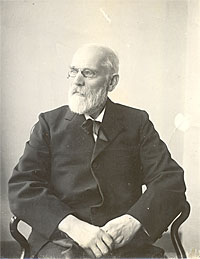Johannes Diderik van der Waals
written by Shania Oke
Johannes Diderik van der Waals was a Dutch theoretical physicist known for his work on thermodynamics. He is associated with the van der Waals equation, van der Waals forces between stable molecules, van der Waals molecules bound by van der Waals forces, and van der Waals radii.

Biography
Early Years
Johannes Diderik van der Waals, the eldest of ten children, was born in Leiden, Netherlands on November 23, 1837. He was born to Jacobus van der Waals and Elisabeth van den Berg.
Education
Being a child of a 19th century working-class family, van der Waals did not have the opportunity to attend a secondary school that would have allowed him to enter any university. At fifteen years old, he finished his “advanced primary education” and then went on to become a teacher's apprentice in an elementary school. By 1861, he completed courses and received the qualifications to become a primary school teacher.
Even though he was not qualified to attend the University of Leiden due to his lack of early education in classical languages, van der Waals attended math, physics, and astronomy lectures in 1862. Fortunately, the University of Leiden implemented a program that allowed other students to take up to four courses a year.
The following year, the Dutch government started HBS which was a secondary school education program for children of higher middle class families. Still the head teacher of an elementary school, van der Waals made every effort to become a HBS teacher by spending the subsequent two years studying during his spare time in order to prepare for the required exams. Finally, in 1865, van der Waals was given a physics teacher position at a HBS in Deventer and then transferred to a HBS in The Hague a year later. Because of close proximity, this new position allowed him to continue his courses at the University of Leiden.
Later Years
Just before assuming his position at the HBS in Deventer, van der Waals married Anna Magdalena Smit.
The law regulating university entrance that prohibited van der Waals from pursing higher education was altered and the minister of education was given the power to exempt students from the study of classical language. Fortunately, van der Waals was given this privilege and passed the necessary math and physics qualification exams in order to pursue his doctorate. During his time at the University of Leiden, he studied the behavior of gases and demonstrated that the liquid and gas phases of a substance are of the same nature allowing the behavior and transition of said substance between states could be accurately predicted. His work was centered on the idea that molecules are of finite size and attract each other which was still a disputed scientific concept at the time.
At the age of 36, van der Waal defended his doctoral thesis (On the Continuity of the Liquid and Gaseous State) which covered the topic of substance continuity during gaseous and liquid states as well as new concepts of molecular volume and molecular attraction.
Van der Waals was selected to be the first professor of physics at the newly established Municipal University of Amsterdam in September of 1877, and had two very notable colleagues at this institution - Jacobus Henricus van’t Hoff and Hugo de Vries. Van der Waals worked at the Amsterdam University until he retired at 70. His son, Johannes Diderik van der Waals, Jr., who was also a theoretical physicist took his place at the University. In 1910, the 72-year-old van der Waals was awarded the Nobel Prize in physics for his research on gaseous and liquid states of matter and later died at the age of 85 on March 8, 1923.
Scientific Contribution
Van der Waals Equation
Van der Waals Radius
Van der Waals Force
Honors
Connectedness
- How is this topic connected to something that you are interested in?
- How is it connected to your major?
- Is there an interesting industrial application?
History
Put this idea in historical context. Give the reader the Who, What, When, Where, and Why.
See also
Are there related topics or categories in this wiki resource for the curious reader to explore? How does this topic fit into that context?
Further reading
Books, Articles or other print media on this topic
External links
Internet resources on this topic
References
This section contains the the references you used while writing this page